|
Displaying items by tag: juan gris
Sotheby's New York announced it will offer the collection of Chicago philanthropist Jerome H. Stone over a series of auctions this spring. Stone assembled the collection over the course of the 1950s and '60s with the help of his wife Evelyn. It consists of blue chip works by artists such as Fernand Leger, Joan Miró, Alberto Giacometti, Juan Gris, and Marc Chagall, that together are expected to bring in more than $40 million.
Stone, who built his family business, Stone Container Corporation, into a national multi-billion dollar corporation, and later founded the International Alzheimer's Association, often bought from leading dealers including Pierre Matisse and Sidney Janis.
A long-standing restitution dispute between Germany's Kunstsammlung NRW and the heirs of the Jewish art dealer Alfred Flechtheim, regarding the provenance of Juan Gris work, "Die Welt" reports. The museum has called on the panel of experts from the so-called Limbach Commission to adjudicate the ongoing issue. The commission's rulings will be officially non-binding, but can hold significant sway in deciding restitution cases. The museum has asked the help of the panel of experts from the Limbach Commission to adjudicate the case.
The Kunstsammlung NRW claims that after years of provenance research it has not any found evidence to support beyond a reasonable doubt that Juan Gris's work "Guitar and Ink Bottle on a Table" (1913) belonged to the Jewish art dealer.
On October 20, 2014, New York’s Metropolitan Museum of Art will present the most important exhibition of the essential Cubists -- Georges Braque, Juan Gris, Fernand Léger, and Pablo Picasso -- in over 30 years. “Cubism” will feature iconic works from the Leonard A. Lauder Collection, which is unmatched in its holdings of Cubist art. Lauder, a philanthropist and cosmetics mogul, promised his collection to the Met in April 2013. “Cubism” will mark the first time that the collection will be shown in public.
The exhibition will explore the invention and development of Cubism, a movement that transformed the landscape of modern art. Cubism departed from the traditional interpretations of art, challenged conventional perceptions of space, time, and perspective, and paved the way for abstraction -- a concept that dominated the art world for much of the 20th century.
Organized to mark the 50th anniversary of the death of Georges Braque (Argenteuil-sur- Seine, 1882−Paris, 1963), this large retrospective covers all the phases of the career of one of the most important artists of the 20th century. As one of the creators of Cubism, along with Pablo Picasso and Juan Gris, and a pioneer of the papiers collés (glued papers), Braque focused his later work on the methodical exploration of still-life and landscape. He was considered the French painter par excellence, inheriting the classical tradition and also a precursor for the abstraction of the post-war period.
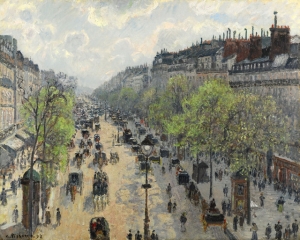
On February 5, Sotheby’s London’s Impressionist and Modern Art Evening Sale fetched 163.5 million pounds, significantly more than its pre-sale estimate of 128.4 million pounds. Out of the 89 lots offered, 10 failed to find buyers.
The highlight of the sale was Camille Pissarro’s ‘Boulevard Montmartre, Matinee de Printemps,’ a street scene that sold for a record 19.9 million pounds, nearly five times the previous record for the Impressionist master at auction. The painting, which is widely considered to be one of the most important Impressionist works to appear at auction in the last decade, was originally owned by the Jewish industrialist, Max Silberberg. During World War II, the Nazis forced Silberberg, who perished in a concentration camp, to get rid of his entire collection of 19th and 20th century artworks. ‘Boulevard Montmartre, Matinee de Printemps’ was restituted to Silberberg’s family in 2000.
The auction also saw the highest price for a Vincent Van Gogh painting offered at auction in London when ‘L’Homme est en mer’ sold for 16.9 million pounds. Other highlights included a print by Pablo Picasso titled ‘Composition au Minotaure,’ which sold for a record 10.4 million pounds and a work on paper by Alberto Giacometti titled ‘Homme Traversant une Place par un Matin de Soleil,’ which achieved a record 8.5 million pounds.
Two weeks of London sales kicked off on February 4 at Christie’s where works by Picasso, Rene Magritte and Juan Gris helped an auction reach 177 million pounds, a record for a sale in London. During the sale, Gris’ still-life ‘Nature Morte a la Nappe a Carreaux’ sold for 34.8 million pounds, a world record for the Spanish artist at auction.
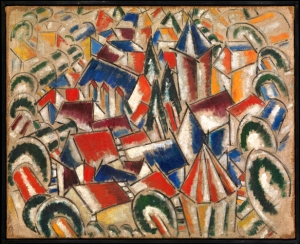
After donating 78 Cubist masterpieces to New York’s Metropolitan Museum of Art in April, philanthropist and cosmetics mogul Leonard A. Lauder will add Fernard Léger’s The Village to the bequest. Lauder has been interested in the painting for several years and provided the Met with the funds necessary to acquire the work. The painting went on display in the museum’s Lila Acheson Wallace Wing for Modern and Contemporary Art this week, where it will remain on view through the end of the year.
Painted by Léger in 1914, The Village depicts a church and neighboring buildings surrounded by trees. The country scene differs from most of the French artist’s paintings, which tend to capture more urban environments. The Village was in a private collection for nearly a century and was not publicly exhibited during that time. Thomas P. Campbell, the Met’s director and CEO, said, “Leonard Lauder is dedicated to creating the greatest collection of Cubist art in the world and to ensuring that these works will be accessible to the millions of people who visit the Met. Léger’s Village certainly demonstrates that unparalleled commitment. It is a rare and beautiful painting, in pristine condition.”
Lauder’s original gift, which is estimated to be worth around $1 billion, includes works by Pablo Picasso, Georges Braque and Juan Gris. Together, these works tell the story of a movement that transformed the landscape of modern art. Cubism departed from the traditional interpretations of art, challenged conventional perceptions of space, time, and perspective, and paved the way for abstraction, a concept that dominated the art world for much of the 20th century.
The entire Leonard A. Lauder Cubist Collection will go on view at the Met on October 20, 2014. The exhibition will remain open to the public through February 16, 2015.
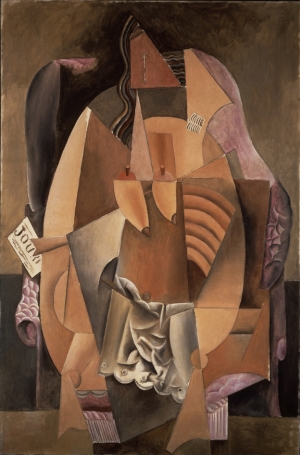
Pablo Picasso’s (1881-1973) Woman in an Armchair (Eva) (1913), which was recently gifted to the Metropolitan Museum of Modern Art by philanthropist and cosmetics mogul, Leonard A. Lauder, is currently on view in the institution’s Lila Acheson Wing for modern and contemporary art. The painting will exhibited for three months as part of a preview of Lauder’s monumental bequest to the museum.
Lauder’s gift, which is said to be worth at least $1 billion, includes 78 Cubist paintings, drawings, and sculptures and will significantly improve the Met’s 20th century holdings. The gift includes 33 works by Pablo Picasso (1881-1973), 17 by Georges Braque (1882-1963), 14 by Juan Gris (1887-1927), and 14 by Fernand Léger (1881-1955). The entire Lauder collection will be exhibited at the Met during the fall of 2014.
Woman in an Armchair (Eva) is one of Picasso’s most arresting paintings. A portrait of his mistress, Eva Gouel, the work epitomizes the Cubists’ rejection of the traditional interpretations of space, time, and perspective. The highly eroticized masterpiece was lauded by the founding father of Surrealism, André Breton (1896-1966), in his groundbreaking text Surrealism and Painting (1928).
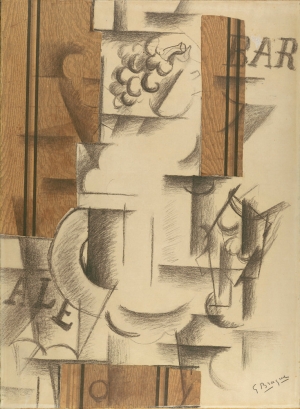
Officials at the Metropolitan Museum of Art in New York have announced that philanthropist and cosmetics mogul Leonard Lauder will donate $1 billion worth of art to the museum. The gift includes 78 Cubist paintings, drawings, and sculptures and will significantly improve the Met’s 20th century holdings. The Leonard A. Lauder Collection includes 33 works by Pablo Picasso (1881-1973), 17 by Georges Braque (1882-1963), 14 by Juan Gris (1887-1927), and 14 by Fernand Léger (1881-1955); for a private Cubist collection it is unmatched in its quality and breadth.
Highlights from the Lauder Collection include Picasso’s landscape The Oil Mill (1909), which was one of the first Cubist images to be reproduced in Italy; Braque’s Fruit Dish and Glass (1912), the first Cubist paper collage ever created; and Picasso’s Head of a Woman (1909), which is considered the first Cubist sculpture. Together, these works tell the story of a movement that transformed the landscape of modern art. Cubism departed from the traditional interpretations of art, challenged conventional perceptions of space, time, and perspective, and paved the way for abstraction, a concept that dominated the art world for much of the 20th century.
Lauder acquired his first Cubist works in 1976 and has maintained his remarkable dedication to collecting for nearly 40 years. He continues to collect and is committed to looking for new opportunities to add to his gift to the Met. In coordination with Lauder’s remarkable gift, the Met is establishing a new research center for modern art. The center is supported by a $22 million endowment that Lauder helped spearhead. Grants for the center came from various trustees and supporters of the Met, including Lauder.
The Lauder Collection will be exhibited for the first time at this Met during the fall of 2014.
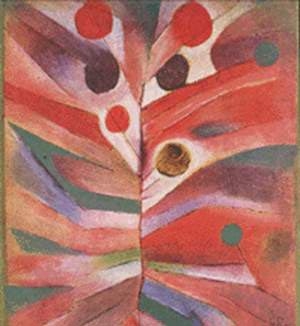
The heirs of Alfred Flechtheim, a prominent Jewish art dealer who fled Nazi Germany during World War II, are urging the German state of North-Rhine Westphalia to return artworks belonging to their relative. The paintings in question, which are by Paul Klee (1879-1940) and Juan Gris (1887-1927), are currently part of the Kunstsammlung Nordhein-Westfalen’s collection in Dusseldorf.
Before the perils of World War II took hold, Flechtheim was an established art dealer in Europe, representing a variety of well-known artists including Klee, Max Beckmann (1884-1950), and a number of French Cubists. Flechtheim ran galleries in Dusseldorf and Berlin, organized many exhibitions, and founded an art magazine. However, Flechtheim’s high standing in the art world made him an easy target for the Nazis. He fled Germany in 1933 shortly after a stream of hateful articles ran in the Nazi press. Flechtheim escaped to Zurich, then Paris before settling in London. After his getaway, Flechtheim’s Dusseldorf gallery was seized and turned over to his former employee Alex Voemel, a Nazi. Flechtheim’s gallery in Berlin was liquidated and his collection, which included works by Pierre-Auguste Renoir (1841-1919), Wassily Kandinsky (1866-1944), Fernand Leger (1881-1955), Georges Braque (1882-1963), and Henri Matisse (1869-1954), was sold.
Mike Hulton, Flechtheim’s great-nephew, claims that Klee’s Feather Plant (1919) and Gris’ Still Life (Violin and Inkwell) (1913) were part of Flechtheim’s private collection and sold under duress for well below their value when he fled Germany. The Kunstsammlung Nordhein-Westfalen does not believe there is enough evidence to support Hulton’s claim. In addition, owners of archives that could help in the case are refusing to let provenance researchers access their information, bringing the dispute to a standstill. Officials from the Kunstsammlung Nordhein-Westfalen assert that if it was proven that Flechtheim was forced to sell the works by Gris and Klee or that he received little to no money for them, that they would part with the paintings, but the current evidence is inconsequential.
Flechtheim’s heirs are currently pursuing restitution for over 100 paintings in museums in the United States, France, Germany, and other European countries.
|
|
|
|
|